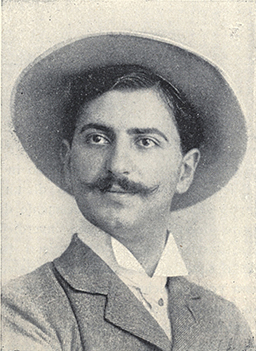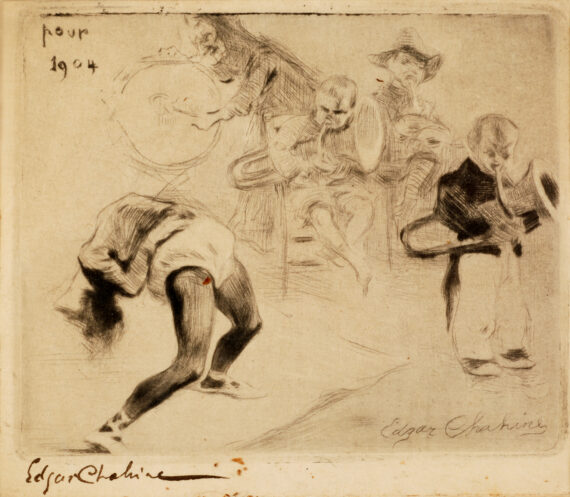EDGAR CHAHINE (1874–1947)
Acrobats
EDGAR CHAHINE (1874–1947)
Acrobats
Drypoint. Dated top left, signed bottom right
and countersigned bottom left.
Made for the illustration of the Paris funfairs by Gabriel Mourey.

Edgar Chahine, who we see here in a self-portrait from his son Pierre’s collection, was born on 31 October 1874 in Vienna, Austria, during a holiday spent by his parents at the thermal baths of Karlsbad (Karvoly Vary in the present-day Czech Republic). His father was one of the directors of the Ottoman Bank in Constantinople. He spent his childhood in the “European and Christian” district, Pera, on the north bank of the Golden Horn. In 1889 his brother, who was a year younger than him, died suddenly of typhoid fever, and from that moment onwards he remained obsessed by microbes.
His parents then divorced. He studied at the Armenian Catholic College of the Mekhitarists in Kadiköy on the Asian bank of Constantinople. His love of painting, however, led him to the classes of Nelkon Tiratsouyan of the Private Academy of Fine Arts opened by the painter from Lyon, Pierre Désiré Guillemet (1827–1878), in the Péra district.
In 1892, when he was eighteen years old, his teacher advised him to continue his training at the Mourat-Raphaël Mekhitarist College on the island of San Lorenzo opposite Venice. There, he attended classes given by the painter Antonio Paoletti (1834–1912) and the sculptor Antonio Zotto (1841–1918); he began learning about painting during the Renaissance period and met Charles Atamian (1872–1947), a future painter like himself.
In 1895, he moved to Paris with his mother to Gare Montparnasse district. He was fascinated by Parisian street life.
He enrolled at the Académie Jullian, taking lessons with orientalist painter Jean-Joseph Constant, known as Benjamin Constant (1845–1902) and Jean Paul Laurens (1838–1921), but most importantly, he met Tigran Polat (1874–1950), who had also begun learning about painting and engraving. During that period he also struck up a friendship with the poet Archag Tchobanian (1872–1954).
In 1896, he exhibited a painting entitled “A Beggar” at the Exhibition of French Artists and the following year, at the age of 23, he was awarded an "honourable" grade at the same exhibition with an oil on canvas entitled “Coin de rue- Marchande de pomme de terre frites.”
He perfected his engraving techniques with Eugène Delâtre (1864–1938) at his Parisian studio at 87 rue Lepic, and from 1899, his mastery of technique and his talent in the three engravings and his drypoint work exhibited at the Salon received critical acclaim.
In 1900, he was awarded the gold medal at the World's Fair in Paris. In the same year he was elected a member of the Royal Society of Painters-Etchers and Engravers in London. In 1901, he took part in the Venice Biennale and was also awarded the gold medal for his engravings.
He had the particularity of engraving copper using a plate that was larger than the sheet. By removing the outline of the press, it looked as if the drawing had been made directly on the sheet.
In 1906, he was overcome by great sadness when his fiancée, Marie Jacobsen succumbed to tuberculosis. He sank into deep depression, and only emerged by wandering around Italy, throwing himself relentlessly into his work. He drew by day and engraved by night in his hotel room.
It was not until fifteen years later in 1921 that he married Simone Julia Gaumet, a young art student, with whom he had a son, Pierre, in 1930.
In 1922, he was the curator of the French pavilion at the Venice Biennale. He took French nationality in 1925. He then had a series of solo exhibitions in different cities across Europe.
In 1926, the year in which a fire in his studio destroyed two thirds of his engravings, he was one of the organisers of the association of Armenian painters of France, “Ani.” He was awarded the Légion d'Honneur [the highest French order of merit] in 1932.
In the 1930s, his works were exhibited in Tiflis, Moscow and Yerevan, Armenia, where he donated one hundred and sixty etchings to the National Gallery in 1936.
The Hermitage Museum in Leningrad held an exhibition of his engravings in 1940, a large part of which were destroyed when his studio suffered flooding in 1942.
During his long career he regularly took part in the Salon des Artistes Français [Exhibition of French Artists] for paintings, and the Salon de la Société Nationale des Beaux Arts [Exhibition of the National Society of Fine Arts], for engravings.
He died at home of a stroke on 18 March 1947 at the age of 73. His grave is the cemetary of Bagneux.
Frédéric Fringhian
